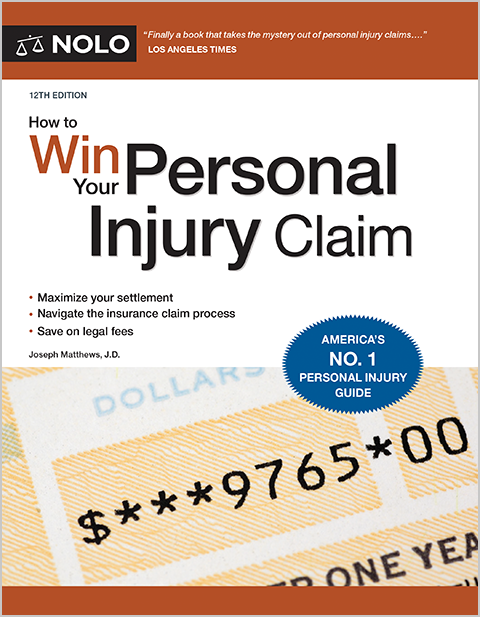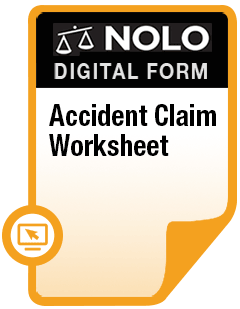After an accident, finding and preserving evidence can be the key to a successful personal injury claim.
"What kind of evidence do I need for my personal injury case?"
If that question or something like it is what brought you here, you're in the right place. Some types of evidence—fact witnesses, medical records and bills, and employment records, for instance—will be useful in almost all injury cases. Other evidence tends to show up only in specific kinds of cases, or in cases that involve especially serious or catastrophic injuries.
Our focus here is on the first category—the personal injury evidence you'll need for most cases. To find out whether you need other evidence for your case, speak to an experienced personal injury lawyer.
Evidence You'll Need for Most Personal Injury Cases
With few exceptions, you'll need this evidence in most personal injury cases regardless of what caused your injuries:
- fact witness contact information and statements
- photos and videos
- your medical records and bills
- employment records, if you were in the workforce when you were injured, and
- a diary or journal.
Fact Witness Contact Information and Statements
A fact witness is anyone who has firsthand knowledge about:
- the event that caused your injuries
- when, where, or how you were hurt
- the injuries you suffered
- the medical care and treatment you received
- your recovery
- your limitations and disabilities, and
- the impact your injuries, treatments, and residual disabilities have had on your life.
At a minimum, make sure you have all fact witnesses' contact information, including a current address, phone number, and email. You'll want to get written or recorded statements, if possible, from any fact witnesses you (or your opponent) plan to have testify at trial, should the case get that far.
If you have a lawyer, it's probably a good idea to have them do the legwork here. When you speak to witnesses, you want to know what they'll say that might help or hurt your claim. A seasoned personal injury lawyer knows what to ask and how to work with witnesses who are reluctant to talk or don't want to get involved.
Depending on the type of case you have, these are some of the possible fact witnesses you might want to track down.
- Scene witnesses. If others were present when you were hurt, they can explain what the scene looked like at the time you were injured.
- Prior or later accident victims. If you learn of others who were hurt in the same place you were, you'll want to speak with them, especially if they were injured in the same way you were.
- Injury witnesses. Of course, you want to know about any witnesses who saw (or claim to have seen) the event that injured you.
- First responders. This group includes police officers, firefighters, and paramedics who saw you, spoke to you, or provided assistance or emergency care at the scene.
- Health care providers. Doctors, nurses, therapists, and other health care providers who treat you for your injuries are (usually) fact witnesses. For the most part, they speak through their medical records.
- Relatives, friends, and coworkers. These are witnesses who might have knowledge of your injuries, treatments, recovery, disabilities or impairments, and work limitations.
When you speak to witnesses who were at the scene when you were injured, you want to know what they saw and what they heard. For example, if a witness heard a police officer say that the other driver was at fault, that's crucial evidence you want to preserve.
(Find out what to do when the insurance adjuster asks you about fact witnesses.)
Photos and Videos
The old saying that "A picture is worth a thousand words" is especially true in personal injury cases. Photo and video evidence can connect with others—insurance adjusters, the judge, or jurors—in ways that testimony and medical records alone simply can't.
Depending on the facts of your case, you want to capture some or all of these things on film.
- The accident scene. If you're able and can do so without interfering with police or other first responders, take pictures of the accident scene right away, before you leave. Get different angles, distances, and points of view. If you can't get pictures right away, return to the scene as soon as possible—and when weather, traffic, and lighting conditions are substantially the same as when you were injured.
- Vehicles and other property. In a case involving physical objects like a car or a defective product, make sure you get pictures of all the objects involved, especially including damages. Also, get pictures of any other property that was damaged, like buildings, traffic signs and signals, and street lights.
- Your injuries. As soon as possible, get photos and video of your injuries, if they show up on film. Also, get pictures of the treatments you received, showing things like stitches, external fixation devices, braces, or a cast. Finally, you want photos and video of you using any necessary medical equipment—a neck brace, crutches or a walker, or a wheelchair, for example.
Your Medical Records and Bills
Medical records and bills are among the most important evidence in any personal injury case. Through them, your health care providers explain:
- how you were injured
- the injuries you suffered
- your treatments, progress, and recovery
- the pain and distress (physical and emotional) you experienced
- referrals to specialists or other providers
- your prognosis, including needs for future care and treatment, and
- any long-term or permanent disabilities and limitations you have.
You'll also need records to document your complete medical history for at least 10 years before the date of your injury. Be sure to get all records for preexisting injuries to the same part or area of your body, or that have caused you to be disabled, regardless of how long ago those injuries happened. Don't forget about work-related injuries, especially if they resulted in a worker's compensation claim.
Employment Records
You'll need employment records to prove your earning history, past and future lost income, and diminished future earning capacity. Your employer's human relations office can provide these records. Try to document at least a five-year earning history.
If you're self-employed, proof of your past earnings will come from your business accounting records and your tax returns. Income from a sole proprietorship gets reported on federal Schedule C. If you own a share of a pass-through tax entity like a partnership or an S corporation, that income is reported on Schedule E.
A Diary or Journal
After you've been hurt, and as you work through treatments and recovery, a diary or journal is a great way to make a record of your experiences. If you're able, try to write an entry every day. Write down as many details as you can recall, including:
- how you were injured
- the specific physical injuries you suffered
- any physical or emotional pain and anguish you experienced
- every health care appointment you have for your injuries
- all treatments you receive, making sure to describe any pain or discomfort you feel
- your prognosis, including likely disabilities and impairments
- any depression, sadness, anger, anxiety, or other psychological symptoms
- conversations you have with health care providers, including counselors and mental health therapists, and
- how your injuries, treatments, and limitations have impacted your ability to work, relax, and engage in hobbies or recreational pursuits, your family life (including sexual activities), and your ability to enjoy life.
If the case goes to court, you might be able to use your diary or journal to assist with your testimony. To use your written entries in your deposition or in court, you'll have to disclose and provide a copy of your journal to the other side's lawyers. So keep your entries factual and truthful, and don't exaggerate or embellish. Anything you write that's untruthful or inaccurate can be fact checked and used against you.
If Police Responded and Made a Report, Get a Copy
Police are likely to respond to motor vehicle collisions and, depending on the facts, might be called to other scenes like a slip and fall or a construction accident. If police respond, there's likely to be a police report, particularly if officers investigate what happened. When it's available, the police report can be very useful evidence.
In an auto accident case, for example, the report likely will include a diagram of the accident scene. It will detail positions of involved cars, trucks, bikes, accident victims (including pedestrians), and other damaged property. It should also mention road and weather conditions, lighting, skid and scrape marks, directions of travel, debris fields, and more.
If you're able to at the scene, ask the officer in charge how to get a copy of the report. If you can't do that, contact the responding department as soon as possible and ask for a copy.
Preserve Physical Evidence When Possible
Fault for an accident sometimes can be proved by a piece of physical evidence. Examples include a broken stair that caused a fall, the dent in a car showing where it was hit, or a defective product that led to an injury. Physical evidence also can help prove the extent of an injury. Damage to a car can demonstrate the forces involved in a collision. Torn or bloodied clothing can be dramatic evidence of physical injuries.
Whenever possible, try to preserve physical evidence that might be key to your claim. When the evidence is small and easy to handle and store, this shouldn't be a problem. In other cases, preserving physical evidence simply won't be cost effective. For example, in a car accident case involving relatively minor damages, it doesn't make sense to purchase and store vehicles involved in the wreck.
If you can't preserve the object itself, make sure to get lots of pictures and videos, as described above.
Get Help With the Evidence in Your Personal Injury Case
Preserving evidence in your personal injury case isn't as simple as checking off boxes on a list. We've covered the kinds of evidence you'll most often use, but our list isn't exhaustive. You might need other evidence too, depending on the facts and circumstances of your case and whether (or how) the evidence might be used at trial.
An experienced personal injury lawyer knows what evidence your case requires, where and how to find it, and how best to preserve it. Even if you plan to handle an injury claim on your own, it probably makes sense to meet with a lawyer to talk about what evidence you need, why you need it, and how you should use it.
For more information, refer to How to Win Your Personal Injury Claim, by Joseph Matthews (Nolo), for tips on how to handle almost any accident situation and what to expect at each step of the claim process.


